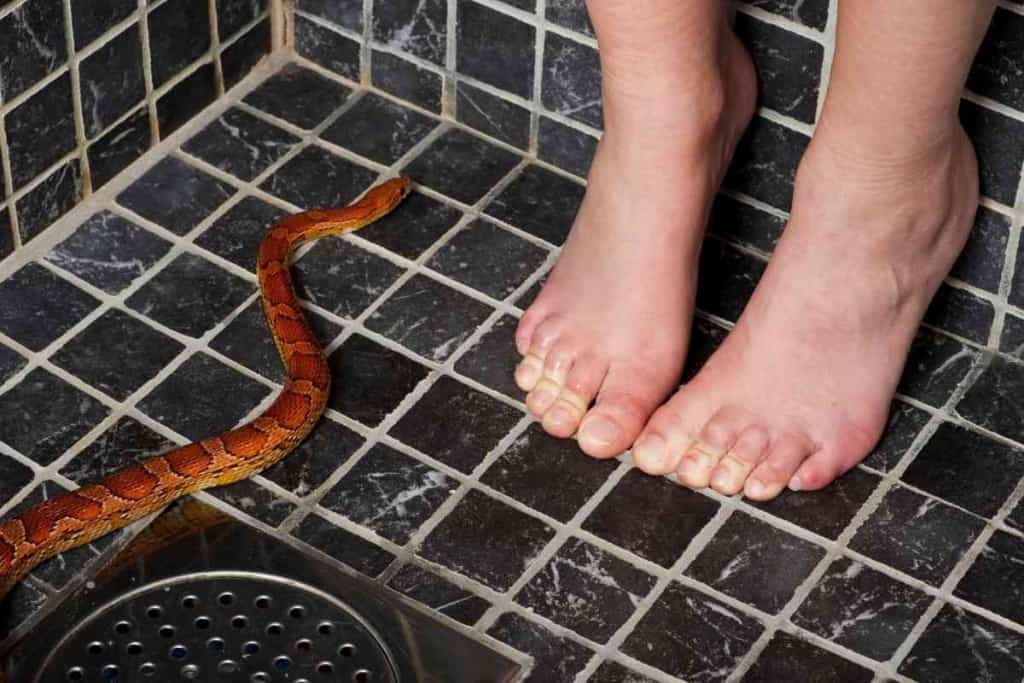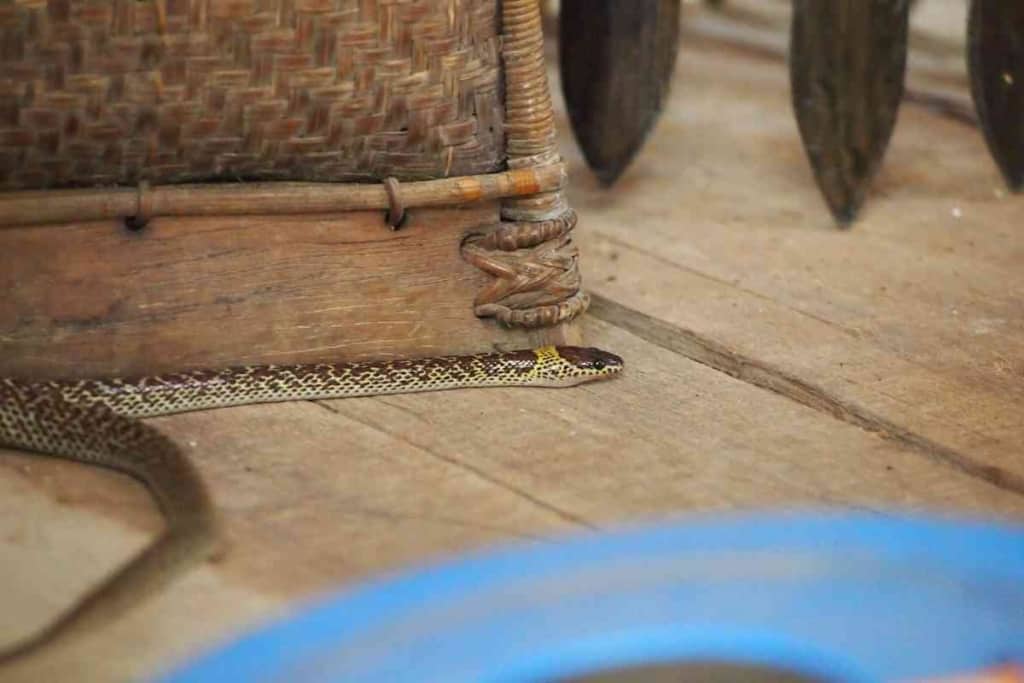How Long Can A Snake Live Lost In A House? (Oh My!)
If you keep a pet snake, you’d better take good care of it to avoid getting lost. How long can a snake live lost in a house if it escapes from the tank? Snakes are master escapists. So if you have a pet snake, getting a tank or an enclosure without an opening within which it can fit is the best way to prevent it from getting out and roaming around the house or getting lost. Most times, snakes escape from their tanks, searching for food, warmth, or a place to sleep.

How long can a snake live loose in the house?
If your pet snake is lost in your house, don’t worry because it can last about 4 to 5 weeks without eating, while some go for two months. However, the length of time a snake can live lost in your house depends on the species, house temperature, and moisture, and if there are rodents or insects, they may stay for a long time.
If you want the snake to roam freely in your house, ensure that it has the right conditions to survive. But remember that you are putting yourself at risk by leaving it out in the open, as snakes are predatory and feed only on meat. So if they get hungry, they may end up biting you or any member of your family or pets. So, it would be best if you made an effort to find the snake and place it back into its tank.
Conduct a thorough search of your house to find your pet snake. You can also place traps to catch it and search all the places that snakes are known to hide in. If your pet snake is lost in the house, here are some places to look and things to do to find it in the fastest way possible.
Step by Step Process of Finding a Snake Lost in a House
You don’t want a snake running loose in your house, whether it’s a pet. Please make a point of looking for it as soon as possible. It will not be easy as they are master escapists and can fit in places you’d never imagined. So be thorough in your search.
Follow this guide to help you return your pet snake to its tank soonest possible.
Don’t Panic
Many people freak out when they can’t find their pet. Don’t freak out if you don’t find your pet snake in its snake because it is just hiding in your house.
Your snake will not die of starvation as snakes can live for about two months without eating anything. However, you must start looking for it as your snake could be affected by cold, lack of moisture, or dehydration.
While you are looking, make a point of placing food and water at strategic places in the house. Or, as you place your traps, place nourishment along with them.
It could only be worse if your house did not have favorable living conditions for the snake, and it has escaped to the outside. Therefore, analyze your house to evaluate whether it’s snake-friendly before starting your search.
Suppose there is a possibility that it’s outside; notify your neighbors and give them a picture of your snake. And make it clear that your pet snake is tame and does not pose any harm.
Place your Other Pets in their Tanks
Despite being tame, snakes become aggressive when they are threatened. So, secure all your other pets, especially cats and dogs.
Do not let them roam about the house when your pet snake is on the loose, as they may end up with a snake bite.
Search Thoroughly in the House
After you have your emotions in check and have secured your pet, it’s time to turn your house upside down as you search for your pet snake.
Search every nook and crook, but first, start with the last place you saw it. And since snakes are diurnal, it’s best to conduct your search at night. And use your phone torchlight.
Places You Can Find a Lost Snake in Your House

Dark Places
Snakes love dark places so if you find that your pet snake is lost, check all the dark spots in your house. This includes the underside of your pieces of furniture, beneath house décor, and other massive items with spaces on the bottom.
You should also check the walls of your rooms if there are cracks or holes. And the most inconspicuous spot is your toilet bowl. Snakes have been found to reside in the toilet bowl; it’s advisable to check before sitting on a toilet, especially at night.
House Ceiling
Snakes can climb in the tiniest places. So if you have an attic, your pet snake may have climbed and hid there. Also, other places a snake can hide in your house include tree decors.
Although basements are cold, snakes can hide there, especially if things are stored there, as they will provide warmth. So remember to check there too.
Near Heat Sources
If you have cabinets in your kitchen, the snake may be hiding as the kitchen is ever warm, so remember to check beneath the oven and all the cabinets. Check your clothes cabinets and dirty clothes basket, as the snakes love burrowing, and your heaped clothes provide an excellent place for just that.
Other places you should check include the
- Rafters
- Door and window frames
- Water pipes
- Septic tanks
- Air ducts
- Baseboard heaters
- Newspapers
- On top of your curtain rod
- Drawers
- Warm appliances such as the furnace, computers, refrigerators, and gaming consoles
- Bookcases
- Under the bed
- Firewood piles
- Fireplaces
Things To Do To Lure Out A Lost Pet Snake In A House
If your pet snake has escaped from its tank and your house search is unfruitful, it’s time to consider using treats to lure your snake out of hiding.
You can use the following methods.
Place Flour on the Floor
Snakes love flour, and it may be one of the easiest ways to lure your pet snake out of hiding. So pour a visible layer of flour on the floor.
And within no time, you will find your snake slithering over the flour. Leave the doors open so that the snake doesn’t have to climb walls and you lose track. Create a flour trail that leads to the snake’s tank. You can use this method combined with others to lure it back to the tank.
Make it that the snake cannot veer out of the floor trap and that it’s away from people. You can also place some treats and water along the way and ensure they are not exposed, as snakes love hiding. Check to make sure your traps are intact, and you’ll trap your snake in no time.
Create a Warm Environment in a Single Room in your House
Snakes love warm places that are cozy and comfortable, especially when they want to nap. Snakes are ectothermic.
This means that they require warmth to survive. So, if you’re going to lure out your pet snake, lower the temperature in the whole house and only leave one room with a favorable temperature for your snake.
Lowering the temperature will force your snake out of hiding in search of warmth. Ensure that the room you choose has a favorable temperature and has all the windows and doors closed. And that there the places where your snake can hide are in the open to make your search easy.
Use Dominoes
Luring out a lost snake in your house can be challenging and time-consuming, so you must do all to trap it. You can use several methods at once, and maybe one may be successful. Dominoes are known to attract snakes and may increase your chances of luring them out.
Strategically arrange your dominoes. For instance, you can set them in two parallel lines in the middle.
This can lead your snake from the tank to create a dominoes path. As it moves on the dominoes, the sound and the feel of dominoes will have it captivated such that it won’t notice getting into its tank.
Ensure that all your pets and family members are not near, as snakes get aggressive when they feel threatened and may bite. You can use dominoes together with the flour.
Pennies
Like dominoes, place pennies in a vertical position where you feel your snake can pass through as it explores the house.
And the moment it slithers through them, they will go against each other, making noise, thus alerting you of its position. You will have to follow the fallen pennies to identify your snake’s hiding place.
Tape
Place tape along the floor, furniture, and walls. As with the flour, your snake will slither on top, and the tape will be attached to its body, dragging it along. This will lead you to its hiding place.
Traps
Set traps around the house and cozy them by placing warm things, food, and water. Snakes love holes, so use traps that have holes and place treats that will lure them inside the trap. The best is to create a flour trail that leads to the traps or a dominoes pathway.
After finding it, ensure that the tank has no gaps within which the snake can fit to prevent it from escaping again. Ensure that the snake’s living conditions are tip-top by providing them with sand and rocks to burrow in, artificial trees to climb, warmth, food, and water.
